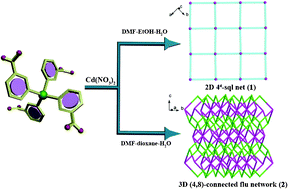Two solvent-modulated Cd(II) metal–organic frameworks (MOFs), [Cd4(TCS)2(DMF)2(EtOH)(H2O)7·4DMF]n (1) and [Cd2(TCS)(DMF)2·4H2O]n (2) (H4TCS = tetrakis(3-carboxyphenyl)silicon, DMF = N,N-dimethylformamide), were constructed from a novel tetrapodal silicon-based linker. In 1 and 2, the TCS ligands exhibit different coordination modes and link mononuclear [Cd(COO)4] and tetranuclear [Cd4(COO)8(DMF)4] SBUs (secondary building units) to give 1 and 2 2D 44-sql net and (4,8)-connected 3D framework with rare fluorite (flu) topology, respectively. Dissimilarities in the geometry of both SBUs are originated from the different solvent systems which result in the formation of different networks in each case. The photoluminescence behaviours of them were also discussed.

